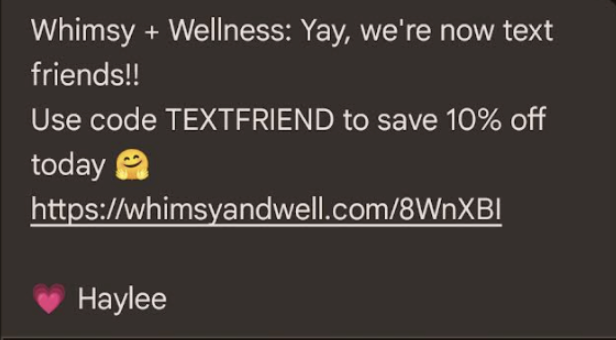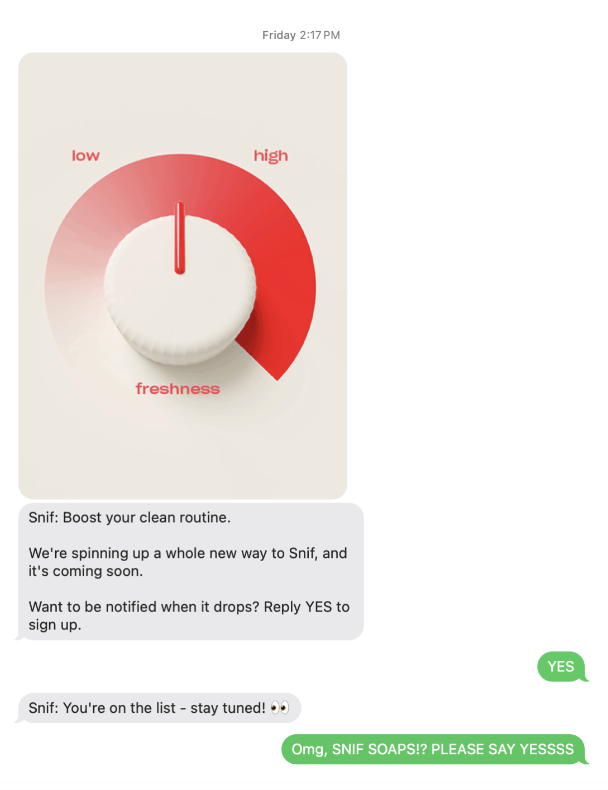SMS Marketing Best Practices for your Subscription and Marketing Campaigns
Last updated: September 19, 2024

As platforms become less reliable, SMS marketing is becoming more attractive as an owned distribution channel.
As Jacob Donnelly wrote in A Media Operator: “[In SMS], We have a channel that has three things:
1. Unbelievably high open rates
Stay ahead and read our Q2 2024 email engagement report to uncover trends & best practices for success:
2. More people are using it for communications
3. It drives activity and generates revenue.”
But as with any new channel, your success will come down to execution. What SMS marketing best practices can we take from retail — and how do they apply to the media space? How can you create campaigns that grab attention without annoying your audience? When does it make sense to text your audience, and what’s best left for email? How many texts are too much?
Read on for SMS marketing best practices to inform your strategy.
SMS marketing best practices to follow
Collect opt-ins from your target users
Starting with a solid subscriber base gives you more data to evaluate your initial campaigns and plan new campaigns. Before launch, encourage your audience to opt into texts from you with some of these strategies:
- Run an interactive poll or quiz testing someone’s knowledge about your vertical, then encourage them to subscribe to SMS upon completion.
- Consider offering a promotional subscription discount for users who sign up via SMS. Or you could offer a discount or special gift to newsletter readers who sign up for SMS.
- Offer first-look access to articles, event announcements, or other releases via SMS
Validate new opt-ins
As with email, ensure your new subscribers are providing the right number via a validation workflow. Besides keeping your audience engaged, this follows SMS marketing best practices and lowers your risk of complaints.
Create your own validation workflow with these best practices from Twilio:
“Send a one-time passcode to the provided phone number to ensure that the user has access to the number. This helps prevent the user from providing someone else’s phone number, helps your business ensure unique sign ups, and is essential for future deliverability of authentication passcodes or notifications.
Build retry buffers into verification workflows. Humans are impatient, so we recommend building retry logic into your phone verification interface. The Verify API will start rate limiting requests after you attempt to send an OTP to the same phone number more than 5 times in 10 minutes without verifying the number. Retry buffers help prevent both accidentally spamming users and hitting API rate limits.
Keep phone numbers visible in enrollment flow and allow users to edit the phone number. Typos happen, so for phone verification use cases (as opposed to ongoing login or two-factor authentication), display the complete phone number in the interface so the user can detect and fix any mistakes instead of waiting helplessly for a verification code.”
Start with a crawl, walk, run approach
There’s nothing more exciting than launching a new channel. And it’s definitely more fun to write new texts, find some sample GIFs, etc., than focus on fundamentals. But if you start sending ad hoc texts to your list without a solid strategy, you’re going to get unsubscribes.
Before pressing send, make sure you:
- segment your new SMS subscribers by demographic, behavior, and/or purchase history
- plan automated campaigns around key transactional use cases, like upcoming subscription renewals and subscription confirmation
- determine key performance KPIs, as well as a process for checking in, implementing and monitoring follow-up in response to audience feedback
Not sure where to start? Stay tuned — we’ll tell you how to do all that next:
Create automations around key transactional use cases
We recommend sticking with transactional use cases until you’ve built solid engagement over SMS, then branching out to education, loyalty and editorial campaigns.
Some places to start:
- Upcoming subscription renewal messages – Message anyone whose subscription is set to expire in 30 days. Prompt them to renew their subscription, then link to your payment platform (For best results, combine SMS outreach with email and personalizations.)
- Upcoming credit card expiration messages – Message anyone whose credit card is set to expire in 30 days. Prompt them to update their information, then link to your payment platform (As above, we recommend complementing your SMS outreach with email and on-site personalizations.)
- Payment confirmation messages – Message anyone with a completed payment, then link to their receipt and/or shipping information
- Payment failure messages – Message anyone with a failed payment, asking them to update their payment information, then link back to your payment platform
- Subscription confirmation messages – Send a welcome message to anyone that’s subscribed to your publication in the last 24 hours, then link to a welcome page, onboarding series or their online account
- Abandoned cart messages – Send a message to anyone that visits a subscription landing page, but bounces before completion
Determine key KPIs per SMS marketing best practices
Before launching your campaigns, identify a few key KPIs to center your strategy around. The most important KPI for each campaign depends on the goal: For subscription renewals, you want to optimize for clicks and conversions. But if you’re promoting your editorial content over SMS, website traffic from SMS might be more important.
As you ramp up, evaluate your strategy along these metrics:
- Click rate
- Conversion rate
- Cost per acquired subscriber
- Website traffic from SMS
- Reply rates
- Subscriber list growth
(Note: Open rates aren’t indicative of success for SMS — Some opens will come from people who will open your text just to get rid of your push notification.)
Set, optimize, and adjust your sending cadence according to SMS marketing best practices
SMS helps you reach your audience more quickly and directly than any other channel. But it’s also the most subject to user fatigue: Texts come with the expectation of a near-immediate response. So if your audience scrambles for their phone only to see an irrelevant ad from you, they’re unsubscribing sooner or later.
So how can you follow SMS marketing best practices without annoying your audience? As with email, start slow and experiment to find the best sending cadence that works for you. Here’s where to start:
Ask yourself “Could this be an email?”: Not every conversation needs to be a meeting — and not every message needs to be a text. As mentioned, texts tend to demand an immediate response. So if your text doesn’t lend itself to an immediate response, consider making it an email instead. This alone will help you limit your sending volume and keep your audience engaged.
Start by sending no more than two texts per week — or only sending texts when it’s triggered by a user action (like subscribing to a publication or making a purchase). From there, scale up or down in response to audience needs.
Err on the side of sending too infrequently. Upland data shows that there’s a significant increase in unsubscribe rates when a brand reaches 10-15 text messages per month.
But send even less if possible, especially as you ramp up. A soft touch ensures that you can provide value to your audience over a longer period of time, rather than sending a few overly aggressive texts that backfire.
Create customer journeys tied to key use cases. This ensures that each text has a purpose — and minimizes the risk of audience fatigue.
On your preference pages, let subscribers choose their preferred sending cadence. Let them choose their preferred sending volume (for instance, 3x/week, 1x/week or only as needed) and message types (transactional only, educational/promotional only, or a combination). Your audience will be more receptive to your texts if they have more control over what they get and how frequently they hear from you.
Send texts between 9am and 8pm in the recipient’s local time.
Be conversational
Aim to be conversational and relaxed without sacrificing clarity. No need to reinvent the wheel here: Even a “yay” or thoughtfully placed emoji tells your audience that you appreciate them — and puts them in the right frame of mind to keep the conversation going. Take this example from wellness brand Whimsy + Wellness:

But every brand is one cringy pop culture reference or wrong emoji away from going full “How do you do, fellow kids?”

So how can you be casual without being cringe? Here’s some do’s and don’ts to guide your copywriting:
Don’t overuse text speak: Abbreviations might save space, but they can also confuse your audience.
Use emojis selectively: Emojis change meaning constantly based on pop culture and also run the risk of annoying your audience. Also worth noting: Using a single emoji reduces your character count from 152 to 66 on Omeda.
Write to a single subscriber, not your whole list. Address recipients by name and always emphasize the benefits to your audience, not your brand.
So you’re starting to nail down your tone. Great. But it’s not enough to sound conversational. To make the most of SMS, you need to be conversational. Text is one of the few channels that puts you in direct conversation with your users. Take advantage by replying to anyone that texts you back.
The time spent will pay off in the form of engagement and loyalty. As Jacob Donnelly recently said in A Media Operator, “If people reply to one of your texts, you should reply back as well. What better way to deepen your relationship with a reader than texting with them? It increases costs and time, but the outcome will be a more engaged reader.”
Build loyalty with educational content and rewards
Once your transactional texts get traction, consider creating more promotional and educational SMS campaigns. Done well, this helps you connect with your readers in a more one-to-one, memorable way while also driving extra engagement for your brand. But the emphasis here is on “done well.”
Some key use cases for SMS include:
Upsell and cross-promotional campaigns: If you’ve got a highly engaged SMS audience, consider promoting related publications to your subscribers over text. (Create effective upsell campaigns with our best practices.)
But upsells are always a little risky. That’s especially true for SMS, where every text carries the expectation of an immediate response. If someone’s just unsubscribed from your newsletter, they’re not going to look kindly on your text asking them to buy a magazine subscription.
Avoid this by aggressively segmenting your SMS list based on someone’s previous engagement and behavior (i.e., target based on someone’s actions, not their demographics). That’ll help you follow SMS marketing best practices and stay connected with your audience.
That makes the difference between being spammy and being valuable. As Stephanie Griffith said in Email Love, “Unfortunately, many senders (often the big ones!) are still batching and blasting with reckless abandon. Yikes. I still get emails (and texts) from brands I have spent lots of money with, who send me emails that are entirely unrelated to what I’ve purchased in the past. I literally told you, with my engagement and my money, what I am interested in. Brands have the data, yet often fail to use it.”
SMS-exclusive announcements and releases: Consider releasing event registration, publications and other time-sensitive content to your text subscribers before opening it up to the rest of your audience. For example, Snif lets subscribers sign up for early access to their new products via SMS.

Loyalty programs: Your SMS audience will likely be your most engaged, passionate audience members. Express your appreciation by offering loyalty programs, content and/or discounts over text.
We recently added SMS as another high-impact channel to reach and engage your audience. Once it’s active, you’ll be able to use SMS marketing best practices to drive subscriptions, renewals, registrations, and more. Learn more about SMS on Omeda and learn how to create your own SMS strategy here.
Subscribe to our newsletter
Sign up to get our latest articles sent directly to your inbox.
What you should do now
- Schedule a Demo to see how Omeda can help your team.
- Read more Marketing Technology articles in our blog.
- If you know someone who’d enjoy this article, share it with them via Facebook, Twitter, LinkedIn, or email.